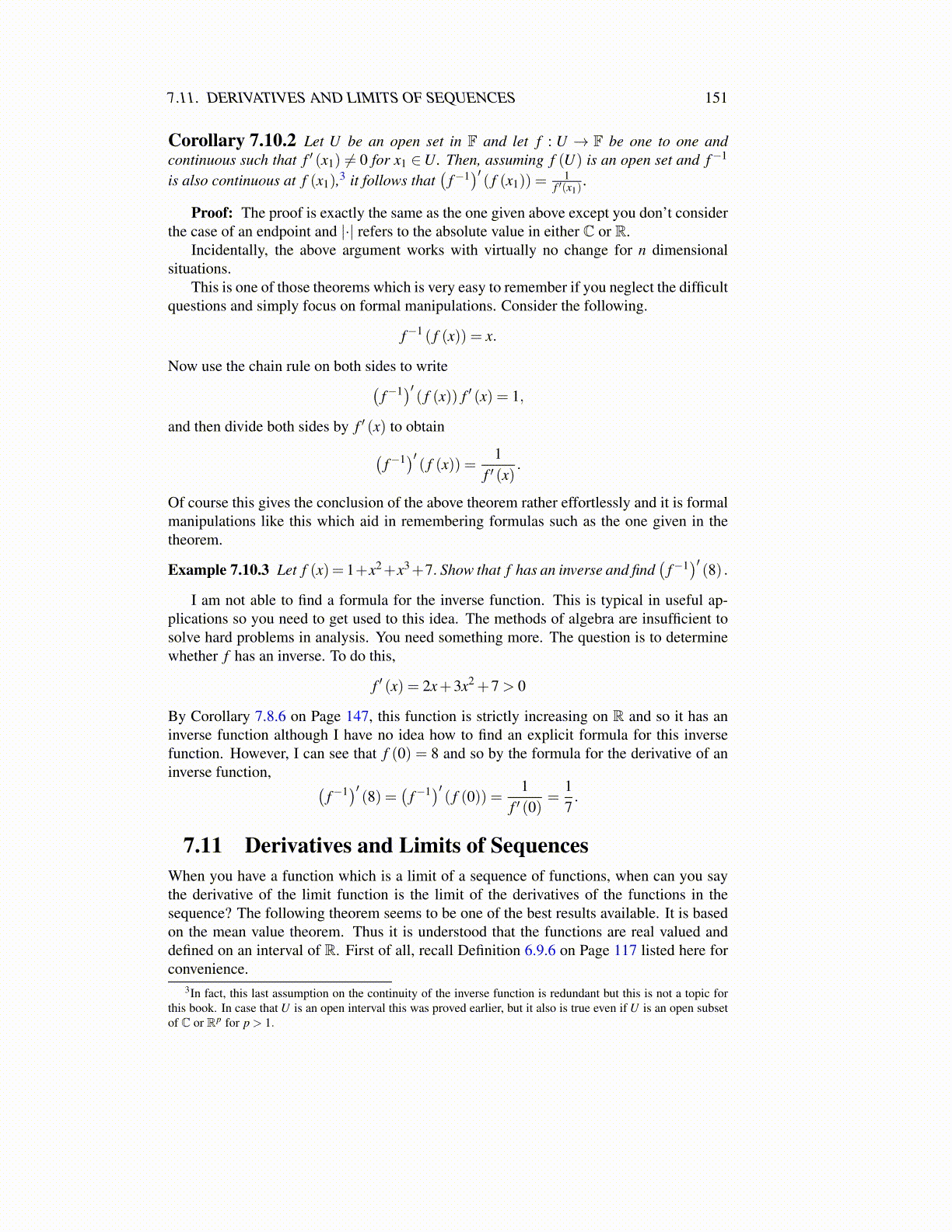
7.12. EXERCISES 151
Proof: Let x ̸= c. Then by the mean value theorem applied to the function x→ fn (x)−fm (x),
|gn (x,c)−gm (x,c)|
=
∣∣∣∣ fn (x)− fm (x)− ( fn (c)− fm (c))x− c
∣∣∣∣=
∣∣ f ′n (ξ )− f ′m (ξ )∣∣≤ ∣∣ f ′n (ξ )−g(ξ )
∣∣+ ∣∣g(ξ )− f ′m (ξ )∣∣
≤∥∥ f ′n−g
∥∥+∥∥ f ′m−g∥∥
By the assumption that { f ′n} converges uniformly to g, it follows each of the last two termsconverges to 0 as n, m→ ∞. If x = c, then
|gn (c,c)−gm (c,c)|=∣∣ f ′n (c)− f ′m (c)
∣∣≤ ∥∥ f ′n−g∥∥+∥∥ f ′m−g
∥∥Thus x→ gn (x,c) is uniformly Cauchy and must converge uniformly to a continuous func-tion hc by Theorem 6.9.7 and Corollary 6.9.10. Also hc (c) = g(c) by the assumption thatf ′k converges uniformly to g. This proves the claim.
Now to complete the proof of the theorem, for c given and x ̸= c,
f (x)− f (c)x− c
= limn→∞
fn (x)− fn (c)x− c
= limn→∞
gn (x,c) = hc (x) .
Since hc is continuous,
f ′ (c) = limx→c
f (x)− f (c)x− c
= limx→c
hc (x) = hc (c) = g(c) .
7.12 Exercises1. It was shown earlier that the nth root of a positive number exists whenever n is a
positive integer. Let y = x1/n. Prove y′ (x) = 1n x(1/n)−1.
2. Now for positive x and p,q positive integers, y = xp/q is defined by y = q√
xp. Findand prove a formula for dy/dx.
3. For 1≥ x≥ 0, and p≥ 1, show that (1− x)p ≥ 1− px. Hint: This can be done usingthe mean value theorem. Define f (x) ≡ (1− x)p− 1+ px and show that f (0) = 0while f ′ (x)≥ 0 for all x ∈ (0,1) .
4. Using the result of Problem 3 establish Raabe’s Test, an interesting variation on theratio test. This test says the following. Suppose there exists a constant, C and anumber p such that ∣∣∣∣ak+1
ak
∣∣∣∣≤ 1− pk+C
=1
C+ k(C+ k− p)
for all k large enough. Then if p > 1, it follows that ∑∞k=1 ak converges absolutely.
Hint: Let bk ≡ k−1+C and note that for all k large enough, bk > 1. Now concludethat there exists an integer, k0 such that bk0 > 1 and for all k≥ k0 the given inequalityabove holds. Use Problem 3 to conclude that∣∣∣∣ak+1
ak
∣∣∣∣≤ 1− pk+C
≤(
1− 1k+C
)p
=
(bk
bk+1
)p